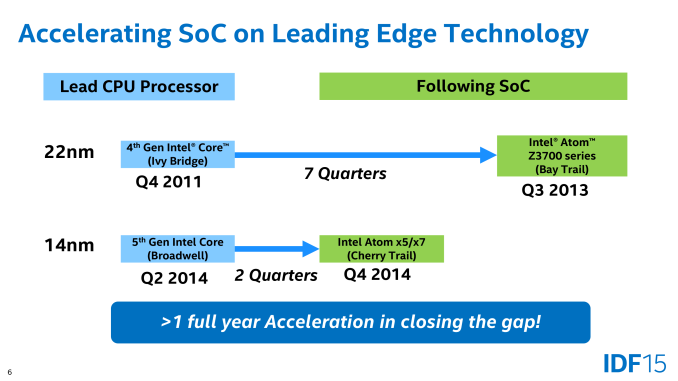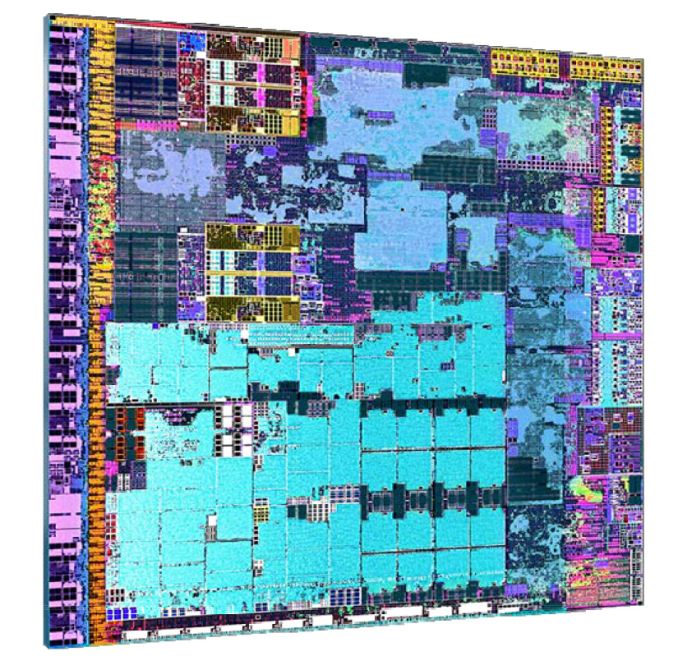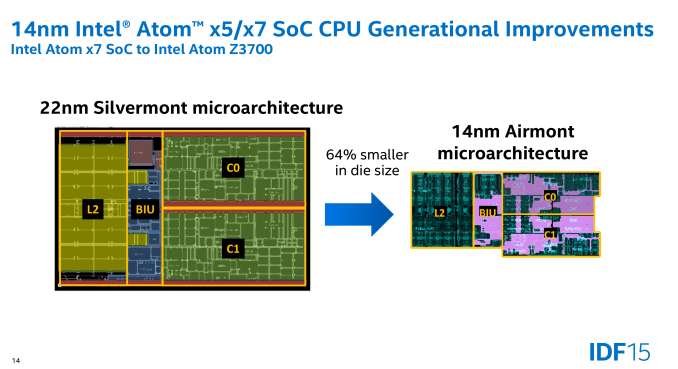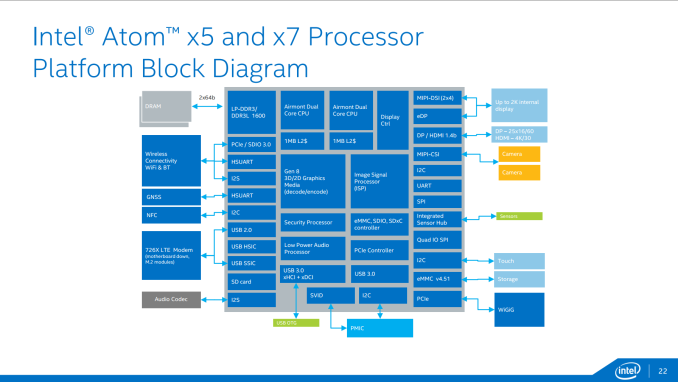The Surface 3 Review
by Brett Howse on May 4, 2015 9:00 AM ESTPowering the Surface 3: Intel’s Atom x7 System on a Chip
I still remember when back in 2011 Intel announced that they were finally going to stop treating Atom as a second class citizen at the manufacturing level, and bring it in line with the company’s mainstream Core processors. After having drawn out the 45nm and 32nm Atoms for too long, and suffering in the marketplace versus ARM as a result – Intel realized that to combat the growing threat of ARM they would need to treat the mobile market more seriously, and they would need to commit their sizable manufacturing advantage to the field to do this.
Now even Intel can’t turn on a dime – processors design begins half a decade in advance these days – so what have seen is a gradual ramping up towards this point. Silvermont, Intel’s first 22nm Atom, would introduce a more modern and better performing out-of-order architecture for Atom, meanwhile Intel would catch up on the manufacturing side by not producing 2 generations of Atoms on the 22nm node. Instead Silvermont would be the only 22nm Atom, and was to be followed by 14nm Airmont roughly a year later.
With Intel’s initial 14nm problems that year later ended up being a bit longer than a year, but in 2015 we’re finally there, and the change is remarkable. Only one generation ago, Intel launched their 22nm process as they always do, with desktop and high-performance laptop processors first. Now with 14nm the tables have been turned; Atom didn’t get first-dibs on 14nm – that went to Core M – but Airmont is still going to beat Intel’s desktop and high-performance Broadwell SKUs to the retail market. In one generation Intel has gone from favoring the desktop to favoring mobile, that’s how serious Intel has become.
That brings us to Surface 3, and the SoC powering it: Cherry Trail. The successor to the Silvermont-based Bay Trail that has powered so many x86 tablets in the last year, Cherry Trail is a distinct tick in Intel's tick-tock cadence. What this means is that Intel has largely retained the same architecture as in Bay Trail, investing in a fairly small number of updates, looking to take advantage of the power consumption and die size (cost) benefits of 14nm. To that end Intel has not even bothered to announce any major architectural changes for Airmont, and while there will likely be a few tweaks made to the CPU to make it work more efficiently on 14 nm, we will have to wait for Goldmont for the next big Atom architecture.
Cherry Trail itself is a fairly small chip. While Intel hasn’t released an official die size for it (no more than they did Bay Trail), from various IDF presentations they have released official numbers for the complete package, and decent photos as well. As a result we can take a decent stab at die sizes, and from Intel’s photos we’d estimate that the die size is around 83mm2. Unfortunately we don’t have anything quite comparable to Bay Trail, though we believe it to be a good bit smaller than Intel’s previous generation tablet SoC. At 83mm2 this would put the die size at quite a bit smaller than Apple’s A8X tablet SoC, and actually is just a hair smaller than the A8 phone SoC’s 89mm2.
Diving a bit deeper, Intel has also released some size data for individual Silvermont/Airmont CPU modules. The dual core modules, which contain the 2 CPU cores along with L2 cache and appropriate glue, have shrunk significantly from Silvermont to Airmont. Overall the Airmont CPU module is 64% smaller than the Silvermont module. And to be clear that does not mean Airmont is 64% of the size of Silvermont, that means that Airmont has been reduced by 64%; relative to Silvermont it is only 36% of the die size. Intel has achieved a better scaling factor than 22nm to 14nm alone, indicating that they have almost certainly enacted further optimizations to bring down the die size as an architectural level.
Moving on to the architecture of Cherry Trail, each Airmont core is a two-wide instruction decode with out of order execution. The L1 cache is 32 KB 8-way associative for instructions, and 24 KB 6-way associative data cache. Level 2 cache is 16-way associative with 1 MB of cache shared between two cores. There will be either two or four core versions available, which means that each SoC will have between 1 and 2 MB of L2 cache depending on the number of cores. There is no L3 cache on Atom.
The System on a Chip (SoC) has support for LP-DDR3 or DDR3L 1600 in dual-channel configuration, and has the blocks needed for PCIe 3.0, USB 2.0, USB 3.0, and support for up to three displays with eDP, DP, and HDMI 1.4b. The built in storage support is eMMC v4.5.1, which is typical for a tablet class processor.
Here is a Block Diagram of the SoC.
The one truely major change to the SoC is the inclusion of Intel's Gen 8 Graphics. Bay Trail used Gen 7 Graphics from Ivy Bridge, and Bay Trail only had 4 Execution Units (EUs) available. Cherry Trail ramps that up significantly, with the latest Gen 8 Graphics from Broadwell now onboard, bringing forward Intel's GPU enhancements over the last two half generations, not to mention the compute enhancements as well.
In terms of execution hardware the x7-8700 model has 16 EUs available, indicating that Intel has spent a significant amount of their die size savings from the 14nm process on graphics resources. Gen 8 has eight EUs per sub-slice but a minimum of three sub-slices in the design, and therefore in order to improve SoC yields the thread scheduler will dynamically allocate the right amount of cores per-subslice to total 16. For comparison, Intel's Broadwell line of Core processors have a minimum of 23 (but most have 24) EUs available, and a maximum of 48, so with Cherry Trail Intel has closed the top-to-top gap in execution resources between Core and Atom to just 3-1.
In Intel’s datasheets, the Atom GPU is labeled as Gen8-LP to designate that this is a low power model being used in a tablet. The base frequency for this GPU is 200 MHz, with a boost of 600 MHz.
In addition to the GPU update, the ISP and hardware decode capabilities get a bump as well. There is full hardware acceleration for decode of H.263, MPEG4, H.264, H.265 (HEVC), VP8, VP9, MVC, MPEG2, VC1, and JPEG, as well as hardware encode for H.264, H.263, VP8, MVC, and JPEG. This marks the first Intel product to ship with the company's full, fixed-function HEVC decoder, making Atom the company's most advanced media processor, at least for this short moment.
The overall SoC is 17mm x 17mm, and the Z-height is 0.937mm, so it is quite a bit smaller than Core M’s 30mm x 16.5mm x 1.05mm package. Intel is not listing a Thermal Design Power for the Atom chip, but is instead listing it as a Scenario Design Power of 2 watts. The CPU base frequency is 1.6 GHz with a turbo frequency of 2.4 GHz, and there is also support for a Low Frequency Mode of just 480 MHz for extra power savings when needed.
| Atom x7-8700 | Atom Z3785 | |
| Architecture | Cherry Trail (Airmont) | Bay Trail (Silvermont) |
| Cores / Threads | 4 / 4 | 4 / 4 |
| Base Frequency (MHz) | 1.6GHz | 1.5GHz |
| Turbo / Burst (MHz) | 2.4GHz | 2.4GHz |
| L2 Cache | 2 MB | 2 MB |
| SDP | 2 W | 2.2 W |
| GPU Architecture | Gen 8 | Gen 7 |
| GPU Execution Units | 16 | 4 |
| GPU Frequency / MHz | 200-600MHz | 313-833Mhz |
| DRAM | LPDDR3-1600 | LPDDR3-1333 |
So what we really have here is a massaged Bay Trail class chip, but the 14 nm process should allow for a higher period of sustained turbo frequencies to help out with performance. It will be interesting to see what Intel does with Goldmont, and if they will add things like hyper-threading or not, but that discussion is for another time.
















265 Comments
View All Comments
asfletch - Wednesday, May 6, 2015 - link
Reading and re-reading this review leads me to one conclusion - the Dell Venue Pro 11 7140 is a superb piece of engineering (if not design) and would be my ideal tablet, if not for the accursed 16:9 screen. It's also a deal-breaker on the T300 Chi. I guess I'm hanging out for a Core M SP4 (although I would prefer a slightly smaller tablet). Oh well.serendip - Wednesday, May 6, 2015 - link
Maybe I'm crazy... I use a Lenovo Miix 2 8" tablet with the older Bay Trail Z3740 as my main computing device and it's been good enough for more than a year. Office documents open fine, I can even run Linux VMs (mainly console stuff), the battery lasts 9 hours and with a portable keyboard, I have my office in under 800 grams.I paid a lot less than the Surface 3's price though. At $499, the Surface 3 is overpriced and the dock pricing is outrageous.
beggerking@yahoo.com - Wednesday, May 6, 2015 - link
mix 2 8" is great, but this is a 10-11".$499 is a bit high (should be sold for $299-399) but the build-in kickstand along..believe it or not, is so important that its actually worth the extra $100...
Yes i have Dell Venue 8, Miix 2, and insignia 8" and they all run great with 1-2 gb of ram and battery lasts forever, all cost < $250
accessories are always overpriced for any model.
Luc K - Thursday, May 7, 2015 - link
The Miix 2 10" actually also started at $499 (you see now discounts since it's > 1 year old device with last gen slower Atom CPU).domski - Wednesday, May 6, 2015 - link
How is pixel density related to backlight power consumption? The article implies the two are connected, but I don't see how.For an LCD, backlight power is usually just directly proportional to screen area and brightness. The pixel density may affect power consumption of the GPU and LCD driver hardware, and maybe also the liquid crystal matrix itself.
Is author (Brett Howse) mistaken? If not, can someone enlighten me about the connection between backlight power and pixel density?
Brett Howse - Wednesday, May 6, 2015 - link
I'm going to pull in a quote from another article which sums it up nicely:"The increase in number of pixels (and transistors powering the display—one for each RGB subpixel) comes with a corresponding increase in the percentage of light being blocked by the transistors and filaments. Thus, the percentage transparent area for each pixel is lower, necessitating a significantly stronger backlight when pixel density is increased."
http://www.anandtech.com/show/5688/apple-ipad-2012...
Brett Howse - Wednesday, May 6, 2015 - link
Also this is one of the advantages of IGZO TFTs is that the actual TFT (Thin Film Transistor) http://en.wikipedia.org/wiki/Thin-film_transistor is less opaque, so more light gets through as compared to Amorphous Silicon TFTs which are the standard (and cheaper) way they are done.buevaping - Wednesday, May 6, 2015 - link
I looked at the Surface 3 at the store today. The sales guy and I were shaking are heads about entry level specs with 2 gigs of ram. "Why doesn't the Windows button not work?" "Oh It probably needs to be shut down and restarted." I don't need a touch device that badly.Luc K - Thursday, May 7, 2015 - link
You can disable the Windows button in the surface app. Not sure why you say 2 GB is major issue. Did you see any issues? Lots of tablets with Atom have 2 GB running 8.1.domboy - Thursday, May 7, 2015 - link
Thank you for the wonderful review. While it makes sense to compare the Surface 3 to current product offerings, especially the Pro 3, I am slightly disappointed that there is not much in the way of comparison to the products it replaces - the Surface RT/2. I realize most of the benchmarks won't run on Windows RT, but the web browser tests and the store version of 3DMark could have been run, as well as some sort of battery life comparison. I'm going to assume that perhaps this is because you don't have older Surface models on hand, but I know this data has been gathered in the past and I think it might have been helpful to include for Surface RT/2 owners that may be considering upgrading.I do think it's a compelling product just to get proper pen support and x86 compatibility, though the RT jailbreak went a long way for me to be able to live with the original Surface RT which is what this would replace in my case. I do know the Asus T100 is faster than the original Surface RT, but I don't know how it compares to the Surface 2 speed-wise.